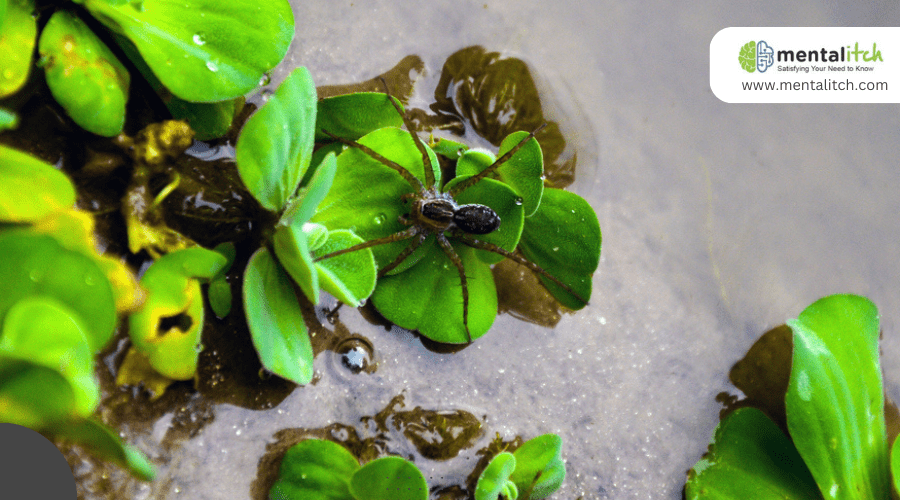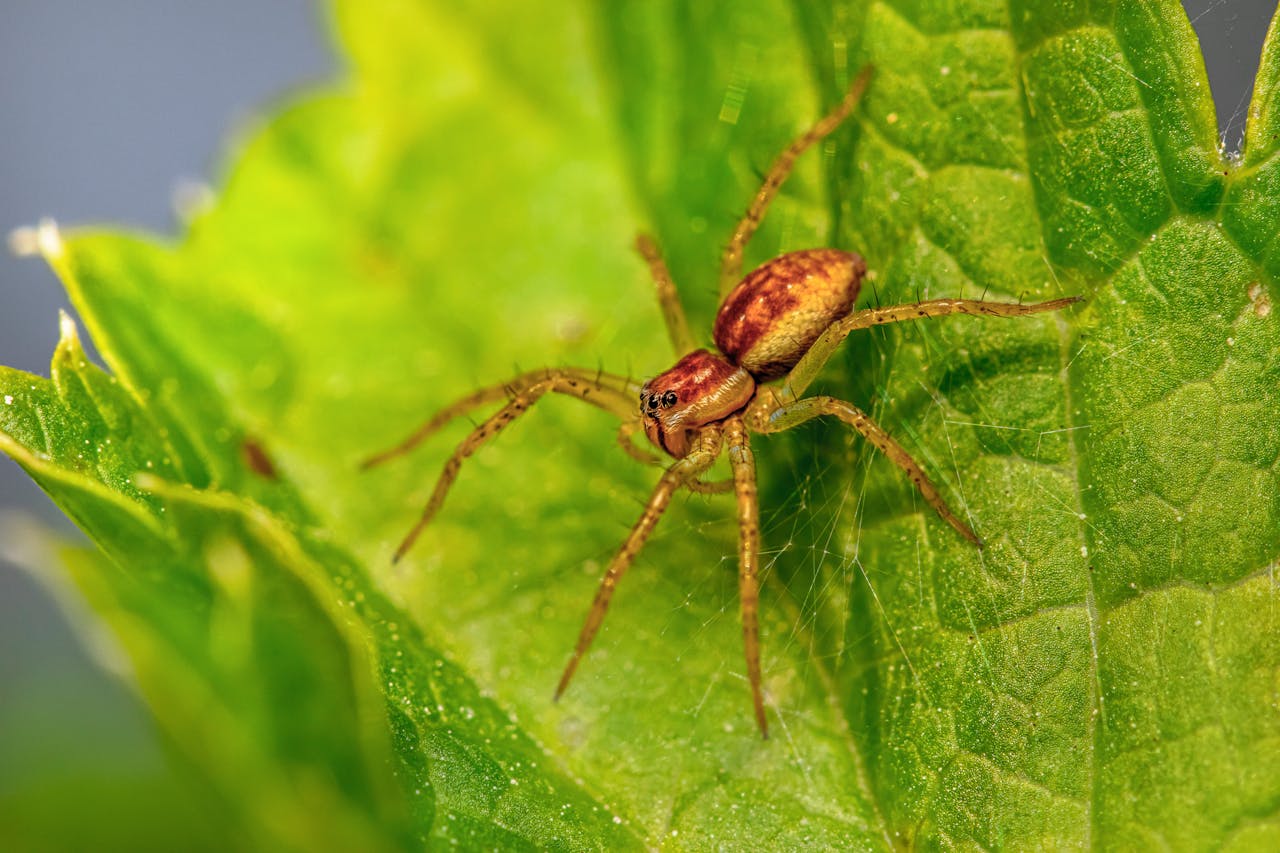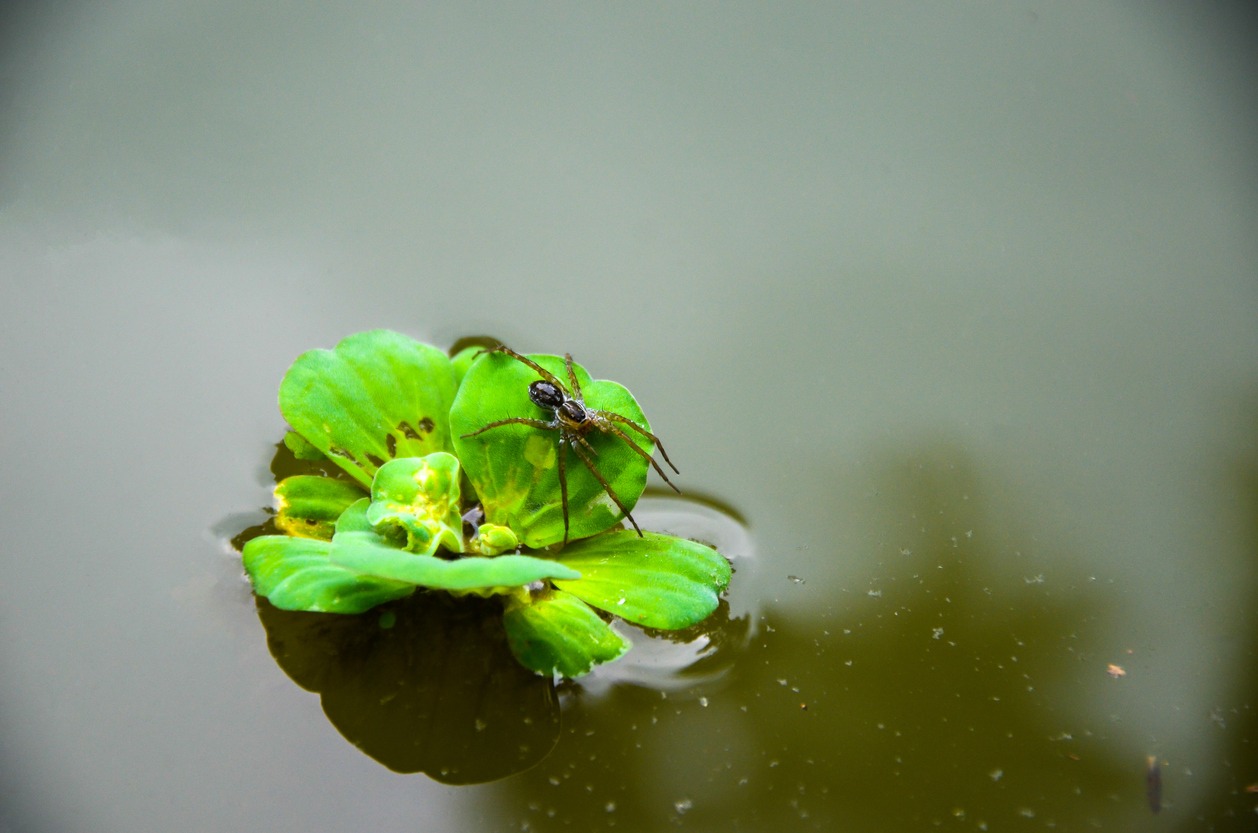Isn’t it fascinating that while you’re considering a swim, the Diving Bell Spider is already busy beneath the surface, crafting its unique underwater home? You’ve likely marveled at the ingenuity of animals, but this spider takes adaptation to a new level. By spinning a web that acts both as a gill and a nursery, it challenges our understanding of what spiders can do. It’s not just about survival; it’s a glimpse into an evolutionary marvel that thrives in an aquatic world, a domain where you wouldn’t expect to find such a creature.
Wondering how this spider breathes underwater or hunts its prey? The answers lie in the intricate details of its life, secrets that underscore its uniqueness among aquatic arachnids.
Aquatic Behavior Unveiled
The Diving Bell Spider, or A. aquatica, stands out as the only spider known to spend almost its entire life submerged, showcasing a fascinating array of adaptations for life underwater. Unlike its semi-aquatic or diving counterparts, diving bell spiders have developed a unique survival strategy that involves air bubbles. You’ll find these spiders weaving watertight webs among aquatic plants, which they then fill with air brought down from the surface. This ingenious method creates an underwater dome, or “diving bell,” allowing them to breathe, rest, and even raise their offspring in a submerged environment.
Their remarkable ability to trap air in their webs isn’t just for breathing; it also aids in hunting. Air bubbles trapped within their diving bells enable them to detect vibrations from prey moving in the water nearby. This sensory adaptation makes sure they’re well equipped to launch surprise attacks from their aquatic hideouts.
While other spiders might venture into water to escape predators or catch prey, diving bell spiders have turned underwater living into an art form. Their lifestyle is a proof of the incredible adaptability of arachnids, making them a unique study subject for anyone fascinated by the intersection of arachnology and aquatic biology.
Habitat and Distribution
While primarily found in freshwater habitats across mainland Europe and extending to northern Asia, the Diving Bell Spider’s unique lifestyle demands specific environmental conditions to thrive. You’ll find this remarkable spider in regions rich with aquatic vegetation, a proof of its specialized adaptation to an underwater life. The Diving Bell Spider is not just any ordinary arachnid; it’s a master of aquatic living, making its home where the water is just right.
| Region | Characteristics |
|---|---|
| Mainland Europe | Abundant aquatic plants, freshwater habitats |
| Northern Asia | Similar to Europe, with suitable underwater environments |
| British Isles | Specific areas with conservation efforts |
The habitat of the Diving Bell Spider includes not only the vast expanses of Europe and Asia but also reaches to the British Isles and even a subspecies in Japan. Each location offers the perfect setting for this spider’s underwater lifestyle, featuring plenty of aquatic plants and suitable water bodies. It’s fascinating how the distribution of the Diving Bell Spider aligns with areas where its habitat needs are met, underlining the importance of preserving these unique aquatic environments for its continued survival.
The Science of the Diving Bell
Understanding how the Diving Bell Spider thrives in its aquatic habitat leads us directly to the marvel of its air-filled diving bells. These unique arachnids craft dome-shaped webs underwater, transforming them into life-sustaining bubbles. They’re not just making homes; they’re engineering a survival mechanism. By capturing air bubbles at the water’s surface through fine hairs on their legs and belly, these spiders bring a piece of the surface world down with them.
This bubble isn’t merely a pocket of air; it’s a multifunctional hub. Serving as a dwelling, a nursery for their eggs, and remarkably, as a gill for efficient gas exchange, it’s central to the spider’s underwater lifestyle. Research has illuminated that about 70% of the oxygen these spiders breathe is absorbed directly from the water through the diving bell. Moreover, the water-repellent hairs that cover their body act like a scuba suit, trapping additional air for respiration.
This intricate relationship between the diving spider and its bell demonstrates a fascinating adaptation to life underwater, highlighting the spider’s unique approach to solving the challenge of breathing underwater without forsaking its terrestrial origins.
Hunting Underwater
Beneath the surface, the diving bell spider engages in a unique form of hunting, utilizing its sensitivity to vibrations to catch prey underwater. This water spider (Argyroneta) has honed an extraordinary method, setting it apart from other aquatic spiders. You’d find it both on the water’s surface and diving deeper, always on the lookout for its next meal.
What’s remarkable is its adeptness at sensing even the slightest ripple signaling an unsuspecting aquatic insect or small fish nearby. This spider doesn’t just wait for food to come to it; it actively pursues prey, showcasing an aggressive hunting style unseen in other aquatic arachnids.
Its hunting underwater isn’t just about proof; it’s a demonstration of its incredible adaptation to an aquatic life. While many spiders might feed on water’s edge, the diving bell spider fully immerses itself in the aquatic environment. It’s fascinating to see how it uses the water not just as a habitat but as a hunting ground, leveraging its unique abilities to thrive in an environment many spiders would avoid.
Breathing Technique
The diving bell spider employs a remarkable breathing technique, using a silk-built diving bell that functions like a makeshift gill, enabling it to breathe underwater. This unique adaptation allows it to live a semi-aquatic life, unlike any other spider. By trapping air bubbles with its silk web, the spider creates a breathable environment that supports underwater respiration. This silk web diving bell is not just a breathing apparatus but also serves as a hub for various activities.
Here’s why this breathing technique is fascinating:
- The silk web diving bell acts as a *sustainable oxygen supply*, allowing the spider to stay submerged for extended periods.
- It showcases an *ingenious use of materials* available in its environment to facilitate underwater breathing.
- This technique emphasizes the spider’s *adaptability*, thriving in an aquatic habitat where most spiders wouldn’t survive.
- The *collaborative nature* of both male and female spiders in utilizing and maintaining the diving bell highlights a unique aspect of their behavior.
This breathing strategy, centered around the silk web and air bubble, sets the diving bell spider apart, demonstrating an incredible evolutionary response to the challenges of underwater respiration.
Reproduction and Lifecycle
Diving bell spiders’ reproduction and lifecycle intricately intertwine with their aquatic habitat, showcasing unique behaviors that safeguard the survival of their offspring. Female diving bell spiders play a vital role, constructing larger air bells as nurseries. These silk structures serve as a shelter, protecting the young through various life stages. Mating and egg-laying occur within this safe haven, highlighting a reproductive strategy finely tuned to their underwater existence.
Here’s a quick glimpse into their fascinating world:
| Aspect | Details |
|---|---|
| Nursery Construction | Female spiders build larger bells for offspring care. |
| Mating Location | Reproduction occurs within the female’s air bell. |
| Male Preference | Females favor larger males for their efficient underwater movement. |
| Reproductive Strategy | The energetic cost of air transfer influences female size and strategy. |
| Behavioral Studies | Research emphasizes the role of male size in mating success. |
These reproductive strategies and mating behaviors not only reflect the diving bell spider’s adaptation to aquatic life but also underline the importance of their habitat in ensuring the continuation of their species. Female diving bell spiders’ dedication to providing for their young, coupled with their selective mating practices, guarantees their unique place among aquatic arachnids.
Predators and Defense
While focusing on their unique reproductive strategies, it’s also important to explore how diving bell spiders defend against predators in their aquatic domain. Living in an environment where air is a precious commodity not just for you to breathe but also as a tool for survival, you’ve got to be crafty. As a diving bell spider, you’re not just floating around waiting for prey; you’re also on constant alert for predators like frogs and fish that share your watery world.
To keep safe, you’ve developed a series of remarkable defense mechanisms:
- Retreat into your diving bell: When danger looms, you can hide within your silk-and-air bubble, making it harder for predators to find you.
- Sense vibrations: The water’s surface vibrations aren’t just ripples to you; they’re a warning system, telling you when predators are near.
- Play dead: Sometimes, the best defense is to do nothing at all. By remaining motionless, you become nearly invisible to hungry eyes.
- Vibratory alarms: These aren’t just for detecting prey; they also help you evade predators, giving you a heads-up to flee or hide.
In your underwater domain, air isn’t just what you breathe—it’s your cloak, your warning system, and sometimes, your best chance at seeing another day.
Impact on Ecosystem
Influencing freshwater ecosystems profoundly, diving bell spiders play a vital role in maintaining the balance of prey populations and the overall health of their aquatic habitats. By adjusting the number of insects, they guarantee ecosystem balance, allowing other species to thrive. Their unique ability to trap fresh air in their diving bells not only showcases remarkable adaptation but also highlights their contribution to the dynamic environment underwater.
| Aspect | Impact | Result |
|---|---|---|
| Prey Population Control | Regulates insect abundance | Maintains ecosystem balance |
| Nutrient Cycling | Facilitates decomposition and energy flow | Supports aquatic life diversity |
| Habitat Creation | Builds underwater webs | Enhances biodiversity |
Diving bell spiders are more than just fascinating creatures; they’re key players in the health of aquatic systems. Their hunting behavior not only curbs the insect population but also influences nutrient cycling, guaranteeing the continuous flow of energy within these ecosystems. By creating submerged habitats, they contribute extensively to biodiversity, offering shelter and breeding grounds for various aquatic species. Studying these spiders provides valuable insights into the resilience and functioning of aquatic ecosystems, highlighting the interconnectedness of life underwater.
Conclusion
You’ve discovered how the diving bell spider distinguishes itself among aquatic arachnids through its ingenious adaptations. Its unique diving bell, underwater hunting skills, and remarkable breathing technique showcase its exceptional ability to thrive in aquatic environments. By constructing air-filled habitats and employing a scuba skin, it not only survives but flourishes underwater, playing an essential role in the ecosystem. This spider’s life, from reproduction to defense against predators, demonstrates nature’s incredible adaptability and innovation.


